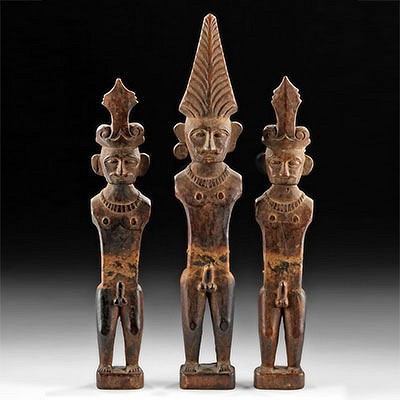5th C. Sasanian Judeo-Aramaic Pottery Incantation Bowl
Lot 59
About Seller
Artemis Gallery
686 S Taylor Ave, Ste 106
Louisville, CO 80027
United States
Selling antiquities, ancient and ethnographic art online since 1993, Artemis Gallery specializes in Classical Antiquities (Egyptian, Greek, Roman, Near Eastern), Asian, Pre-Columbian, African / Tribal / Oceanographic art. Our extensive inventory includes pottery, stone, metal, wood, glass and textil...Read more
Categories
Estimate:
$1,700 - $2,550
Absentee vs Live bid
Two ways to bid:
- Leave a max absentee bid and the platform will bid on your behalf up to your maximum bid during the live auction.
- Bid live during the auction and your bids will be submitted real-time to the auctioneer.
Bid Increments
| Price | Bid Increment |
|---|---|
| $0 | $25 |
| $300 | $50 |
| $1,000 | $100 |
| $2,000 | $250 |
| $5,000 | $500 |
| $10,000 | $1,000 |
| $20,000 | $2,500 |
| $50,000 | $5,000 |
| $100,000 | $10,000 |
| $200,000 | $20,000 |
About Auction
By Artemis Gallery
Jun 25, 2020
Set Reminder
2020-06-25 10:00:00
2020-06-25 10:00:00
America/New_York
Bidsquare
Bidsquare : CLEARANCE - Ancient, Pre-Columbian, Ethno Art
https://www.bidsquare.com/auctions/artemis-gallery/clearance---ancient-pre-columbian-ethno-art-5264
Featuring discounted pricing on antiquities from Egypt, Greece, Italy, and the Near East...plus Viking, Asian, Pre-Columbian, Tribal, Russian Icons, Spanish Colonial, Fine Art, more! Starting prices have been reduced up to 65% from original auction prices - perfect for dealers and collectors. Artemis Gallery info@artemisgallery.com
Featuring discounted pricing on antiquities from Egypt, Greece, Italy, and the Near East...plus Viking, Asian, Pre-Columbian, Tribal, Russian Icons, Spanish Colonial, Fine Art, more! Starting prices have been reduced up to 65% from original auction prices - perfect for dealers and collectors. Artemis Gallery info@artemisgallery.com
- Lot Description
**Originally Listed At $900**
Ancient Near East, Sasanian (Sassanian, Sasanid) Empire, Judeo-Aramaic culture, ca. 5th to mid-7th century CE. A wheel-thrown pottery bowl of a minimalist mastoid form with a conical base, gradually expanding walls, and a thin rim surrounding the basin. Within the basin is a singular line of black-painted Aramaic text that spirals around the basin surfaces roughly seven or eight times. Bowls like this example were traditionally buried face down to lure, catch, and disable demons and were typically placed underneath homes and around cemeteries. Also known as "demon bowls" or "devil-trap bowls," incantation bowls were evidently widely used; for example, nearly every excavated residence in the Jewish Iraqi settlement of Nippur had one buried under or around the premises of the dwelling. Size: 6.8" W x 3" H (17.3 cm x 7.6 cm)
For two stylistically similar examples of incantation bowls from the Sasanian Empire, please see The Metropolitan Museum of Art, accession numbers 32.150.89 and 32.150.90.
Provenance: private J.H. collection, Beaverton, Oregon, USA, acquired in October 2000; ex-Tom Cederlind collection, Portland, Oregon, USA
All items legal to buy/sell under U.S. Statute covering cultural patrimony Code 2600, CHAPTER 14, and are guaranteed to be as described or your money back.
A Certificate of Authenticity will accompany all winning bids.
We ship worldwide and handle all shipping in-house for your convenience.
#153247Minor abrasions to base, walls, rim, and basin, with one chip to rim, fading to painted text within basin, scattered bubbling commensurate with kiln-firing, and light encrustations, otherwise intact and very good. Nice earthen deposits throughout.Condition
- Shipping Info
-
All shipping is handled in-house for your convenience. Your invoice from Artemis Gallery will include shipping calculation instructions. If in doubt, please inquire BEFORE bidding for estimated shipping costs for individual items.
-
- Buyer's Premium



 EUR
EUR CAD
CAD AUD
AUD GBP
GBP MXN
MXN HKD
HKD CNY
CNY MYR
MYR SEK
SEK SGD
SGD CHF
CHF THB
THB
















